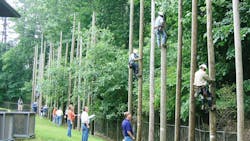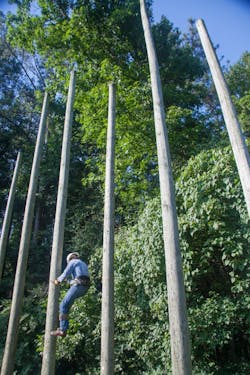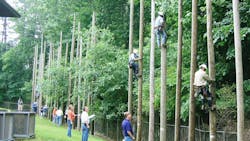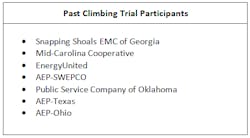Trials Test Climbability of Treated Utility Poles
Pike Electric's Cory McMichael said, "Considering the overall condition and feel, climbing poles treated with oil emulsion was definitely easier, especially compared to poles treated only with chromated copper arsenate (CCA)."
McMichael, a 21-year journeyman lineman, made these remarks after participating in the recent 30-year Climbing Trial, so named because the poles the participants climbed at Lonza Wood Protection's research center were treated with added oil emulsion and exposed to the elements for 30 years.
McMichael added, "I especially thought the poles treated with ET Brown emulsion were easier to climb and looked and felt good to the touch."
How many seconds does it take to get to the top of a utility pole? Those seconds could mean the world to a small child who sits huddled in the dark after a wicked storm has passed or to an elderly woman who needs to call someone to help her get up off the floor after a fall. Or, it could even mean life or death to a lineman as they scale a pole to check lines or complete a necessary repair.
Everyone who is on the grid — especially those who maintain infrastructure — rely on utility poles that they can trust even after those poles have been in the ground for three decades. To ensure they are protected against wood's natural enemies, utility companies have been relying upon poles pressure treated with preservatives.
Protecting poles from termites and fungal decay is critical, but making a lineman's climb easier and safer so that they can do their job is also important.
Traditionally, oilborne preservatives, such as pentachlorophenol (penta), have been chosen by utility companies because they are thought to make poles easier to climb. Poles treated with the waterborne preservative CCA have received a reputation of having a hard shell, making them hard to climb.
This concern for linemen inspired Lonza Wood Protection's research team to find a way to make utility poles treated with waterborne preservatives easier to climb. Tim Carey, Lonza's industrial products specialist, said: "We wanted to provide a clean-to-the touch pole with a long life, low conductivity, and low corrosivity. However, it also does little to soften the wood to make it easy to climb."
Therefore, Lonza developed an oil emulsion treatment called ET utility pole treatment, which is forced into the poles in a vacuum environment.
In order to real-life test the CCA-treated poles that were treated with this new oil emulsion, a series of utility poles were installed at Lonza's research facility located in Conley, Georgia. The CCA-treated poles with oil emulsion were set in 1988 alongside poles treated with CCA alone and with penta to test climbability of the new innovation and also to compare it with the climbability of the other options. Because utility poles treated with these preservatives can be found in lines all around the country, the researchers thought these would be the most important to test.
Carolina Power and Light Climbing Trials
Testing began in 1997 when climbers from Carolina Power and Light attended the first pole climbing trial at the research facility. Linemen were asked to rate the poles on a number of different criteria, the most important of which was climbability. The CCA-treated poles with oil emulsion rated highest with an average of 7.6 on a 1 to 10 scale. Penta-treated poles followed closely at 7.2 and poles treated with CCA only were rated at 4.6.
During the trials, a Lonza spotter is assigned to each lineman who they follow from pole to pole, marking the scores based on the specific climbing categories. Carey said, "The linemen always promise to be tough graders and usually seem surprised to find the poles to be so climbable, especially in the later trials."
Climbing Trial Data
The climbing trials along with years of in-line, real-world climbing have confirmed that treating poles with oil emulsion makes a definite difference to climbability. The next climbing trials are scheduled for 2022 or 2023.
Note: Use biocides safely. Review and follow all product label and safety instructions.
About the Author
Belinda Remley
Belinda Remley has nearly 30 years of experience in the wood pole industry. At Lonza Wood Protection, her responsibilities include technical writing, marketing, and communications. She is a graduate of The University of Southern Mississippi.




